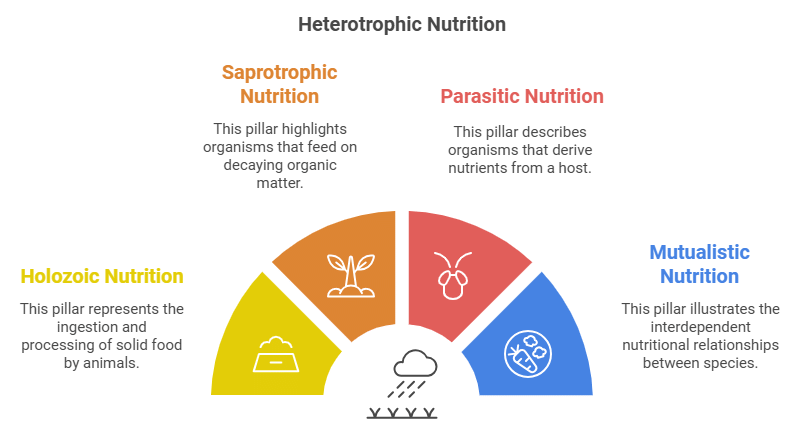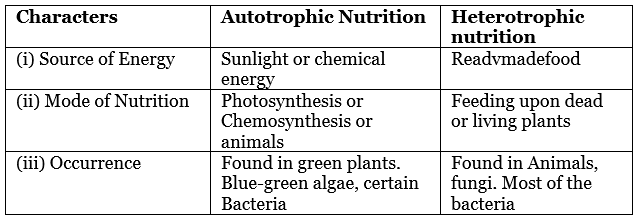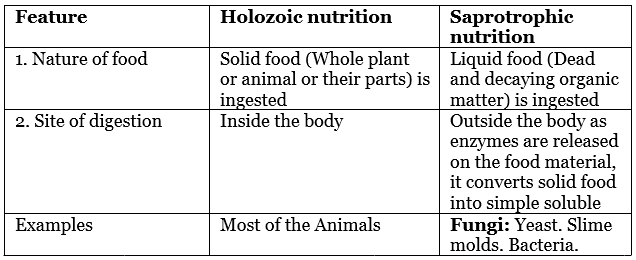Life Processes: Nutrition & Metabolism | Science Class 10 PDF Download
| Table of contents |

|
| What are Life Processes? |

|
| Types of Life Processes |

|
| What is Nutrition? |

|
| Modes of Nutrition |

|
| What is Metabolism? |

|
| Important Terms to Learn |

|
What are Life Processes?
Maintenance of living organisms is essential even if they are moving, resting, or even sleeping. The processes which together perform the function of maintenance of ‘life’ are known as life processes.
- Nutrition, respiration, circulation, and excretion are examples of essential life processes.
- In unicellular organisms, all these processes are carried out by a single cell.
- In multicellular organisms, well-developed systems are present to carry out the processes.
Types of Life Processes
Biology is the study of living things, encompassing plants and animals. Determining if something is alive involves seven life processes: Types of Life Processes
Types of Life Processes
1. Movement: Both plants and animals can exhibit movement, although in different ways.
2. Respiration: The process of obtaining energy from food, occurring in the mitochondria of cells.
3. Sensitivity: Living things are responsive to stimuli in their environment.
4. Growth: All living organisms undergo a growth process, with plants continuing to grow throughout their lives.
5. Excretion: Removal of metabolic waste, with plants eliminating waste through falling leaves and animals through various means.
6. Reproduction: The production of offspring for the survival of the species, occurring through sexual or asexual means.
7. Nutrition: The intake of food for energy and growth, achieved through photosynthesis in plants and consumption of other organisms in animals.
Let us study Nutrition and Metabolism in detail.
What is Nutrition?
Nutrition is the process of taking in food and converting it into energy and other vital nutrients required for life.

- Nutrients are inorganic as well as organic substances which the organisms obtain from their surroundings in order to synthesize their body constituents and use them as a source of energy. The process of intake of nutrients and their utilization by an organism in various biological activities.
- A process to transfer a source of energy from outside the body of the organism (food), to the inside is called nutrition.
- There are various types of nutrients on the basis of function they perform:
(a) Energy foods: Carbohydrates and fats
(b) Bodybuilding foods: Proteins and mineral salts
(c) Regulating foods: Vitamins and minerals
Modes of Nutrition
The method of obtaining food by the organism is called the mode of nutrition. Modes of Nutrition
Modes of Nutrition
1. Autotrophic (Holophytic) Nutrition
The mode of nutrition in which the organisms prepare (or synthesize) their own organic food by using inorganic raw material (CO2 & H2O). They are also called Autotrophs.
(Auto = self, trophic = food)
Example: Plants, Photosynthetic and chemosynthetic bacteria and cyanobacteria etc.

- Light energy absorption by chlorophyll.
- Light energy is converted to chemical energy, and water molecules are divided into hydrogen and oxygen.
- Carbon dioxide is converted to carbohydrates.
(i) Photoautotroph: Those which utilize sunlight for preparing their food
(ii) Chemoautotroph: Those which utilize chemical energy for preparing their food.
 Autotrophic Nutrition
Autotrophic Nutrition
Photosynthesis
- Photosynthesis is an important process by which food in plants is formed.
- The plants make food using sunlight and water, which provides nourishment to other organisms and themselves.
 Process of Photosynthesis
Process of Photosynthesis - Chlorophyll present in the green parts absorbs light energy.
- This light energy is used to split water into hydrogen and oxygen.
- Carbon dioxide is reduced to form glucose during photosynthesis, and the source of hydrogen is water.
- Chlorophyll is essential for photosynthesis and stomata to facilitate the intake of carbon dioxide.
Stomata
- Stomata are pores on the leaves that help in the exchange of gases.
- They are mostly found on the underside of the leaf.
- Each stoma is guarded by guard cells, which control the opening and closing of the pore.
 Stomata
Stomata - The water content of the guard cells is responsible for their function.
2. Heterotrophic Nutrition
The mode of nutrition in which the organisms derive their nutrition from other organisms. They take ready-made organic food from other dead or living plants or animals. The living organisms showing heterotrophic nutrition, are called heterotrophs.
(Hetero = different ; trophic = food)
Example: All animals, fungi, many bacteria and some non-green plants (insectivorous plants), and man.
Types of Heterotrophic Nutrition
(i) Holozoic nutrition (Holo-Complete + Zoon-animal)
- The mode of nutrition in which all animals take in complex solid food material is called holozoic nutrition.
Example: All animals including vertebrates and Invertebrates. - It contains the following steps:
(i) Ingestion: Taking in complex organic food through the mouth opening.
(ii) Digestion: Change of complex food into simple diffusible form by the action of enzymes.
(iii) Absorption: Passing of simple, soluble nutrients into blood or lymph.
(iv) Assimilation: Utilization of absorbed food for various metabolic processes.
(v) Egestion: Expelling out the undigested food.

- Depending upon the type of food habit, animals are divided into three categories:
(i) Herbivores: Animals that depend upon green plants are known as herbivores.
Example: Goat, Cow, Deer, Rabbit.
(ii) Carnivores: Animals that eat the flesh of other animals as food are called carnivores.
Example: Lion, Tiger.
(iii) Omnivores: Animals that eat both plants and animals as food are known as omnivores.
Example: Rat, Pigs, Crows, Cockroaches and Humans.
(ii) Saprotrophic (Sapro - Rotten; Trophos - Feeder) Nutrition
- In this type of nutrition, the organisms obtain their food from decaying organic substances. Organisms are also called Saprotrophs.
Example: Bacteria, Fungi. Saprotrophs
Saprotrophs
(iii) Parasitic Nutrition (para-other)
- The mode of nutrition in which one organism (called parasite) derives its food from other living organisms (Host) is called parasitic nutrition.
Example: Tapeworm, Ascaris, Plasmodium, Liver flukes, Cuscuta etc.
(iv) Mutualistic nutrition
- Mutualistic nutrition can be defined as the interdependent nutrition in which each organism is dependent mutually on the other.
Example: The lichens share mutualistic nutrition between a fungus and an Algae.
Differences between Autotrophic and Heterotrophic Nutrition
Differences between Holozoic and Saprotrophic Nutrition
Note:
Animals that depend upon the blood of other animals known as sanguines.
Example: Bedbug, Mosquito, Leech etc.
Some organisms take in predigested food through their body wall by the process of diffusion. This process of nutrition is known as osmotrophic nutrition.
Example: Tapeworm, Trypanosoma.
Nutrition in Unicellular Organism (Amoeba)
Amoeba is a holozoic and omnivorous animal. It feeds upon microscopic organisms like bacteria, Paramecium, Diatoms, Algae and dead organic matter.
 Nutrition in Amoeba
Nutrition in Amoeba
Nutrition in Amoeba involves the following steps:
- Ingestion: Amoeba has no mouth, so ingestion may occur at any point of body surface but generally it occurs at the advancing end of the body. Ingestion occurs with the help of pseudopodia. The opening of the food cup gradually becomes narrower and narrower, and finally closes. So the food is finally enveloped and taken inside a food-vacuole (called phagosome) along with a drop of water.
- Digestion: Amoeba shows intracellular and vacuolar digestion. In the cytoplasm, food vacuole fuses with lysosomes containing digestive enzymes. In this, the complex and non-diffusible nutrients are changed into simple and diffusible nutrients. Medium inside the food vacuole is first acidic but later becomes alkaline (as in the alimentary canal of man).
- Absorption and assimilation: In absorption, the diffusible nutrients pass through the vacuolar membrane into the cytoplasm by diffusion and are then distributed to all the body parts by streaming movements of the cytoplasm called cyclosis. Due to this, the size of the food vacuole gradually decreases.
In the cytoplasm, a part of the absorbed food is oxidised to produce energy, most of the simple nutrients are combined to synthesize complex compounds. - Egestion: Amoeba has no anus, so egestion may occur at any point on the body surface.
What is Metabolism?
Metabolism refers to a series of chemical reactions that occur in a living organism to sustain life.
- Metabolism is a word used to describe the sum total of all the chemical and physical changes that are constantly taking place in living matter and are necessary for life.
- The word metabolite refers to a substance that undergoes various changes during metabolism.
Example: Carbon dioxide and water are metabolites used in the process of photosynthesis.
Types of Metabolic Process
There are two types of metabolic processes:
- Catabolism
- Anabolism

1. Anabolic pathways or Biosynthetic pathways: In which biosynthesis of organic compounds occurs, or in other words, complex substances are synthesized from simpler ones.
Example: Photosynthesis
In anabolic pathways or processes of anabolism, energy is used (endothermic reactions)
2. Catabolic pathways in which the breakdown of complex organic substances into simpler ones occurs.
Example: Respiration
In catabolic pathways or catabolism, energy is released (exothermic reactions).
Important Terms to Learn
- Nutrition: The processes by which organisms obtain and utilise nutrients (food).
- Food: The substance which is palatable, delicious enough, and energy provider is called food.
Chemically food consists of six essential components:
(i) Carbohydrates
(ii) Fats
(iii) Proteins
(iv) Minerals
(v) Vitamins
(vi) Water - Digestion: Digestion is a catabolic process, in which the complex, non-diffusable, and larger components of the food are broken down into their respective simpler, diffusible and smaller forms with the help of various hydrolytic enzymes in the alimentary canal of living organisms.
Intracellular and Extracellular Digestion
(a) Intracellular Digestion: This type of digestion occur inside the cell cytoplasm. The food inside the cell occurs as a food vacuole. The digestive enzyme in this case is secreted inside the cell. They digest the contents of the food vacuole. So the entire process of digestion occurs inside the cell.
Example: Protozoans [Amoeba], Sponges.
(b) Extracellular Digestion: It takes place outside the cell [i.e. in the intercellular space or a cavity formed by many cells or tissue]. In all animals, this cavity is found as a large canal, called the Alimentary canal. - Hydrolysis: It is a kind of catabolic reaction in which a compound is broken [lysis means break] down into smaller compounds, with the help [addition] of water [hydro = water].
- Carbohydrates: These are the hydrates of carbon in which the ratio among carbon, hydrogen & oxygen is 1: 2: 1. Carbohydrates are the quickest source of energy.
On the basis of their composition, carbohydrates are of the following types:
(a) Monosaccharides: The simplest sugars are called monosaccharides. These sugars cannot be further degraded to produce more sugars.
Example: Glucose, Fructose, Galactose, Ribose, and Deoxyribose.
(b) Oligosaccharides: These are complex sugars, formed by the polymerisation of a few [1 to 10] units of monosaccharides.
Sucrose - Glucose + Fructose
Maltose - Glucose + Glucose
Lactose - Glucose + Galactose
(c) Polysaccharides: These are the most complex carbohydrates, which are the polymers of thousand of units of monosaccharides.
Example: Starch Stored food in plants, Glycogen Stored food material in Animals.
Cellulose: Constituent of the cell wall. - Fats: These are energy-rich compounds. These are the esters of higher fatty acids. [Esters are formed by the addition of alcohol with acids]. Glycerol is a type of alcohol.
- Proteins: Proteins are the polymers of amino acids. Amino acids are held together by means of a peptide bond to form polypeptide chains.
- On the basis of the gross size of food, the mechanism in different animals may be of two main types:
(a) Microphagy: Feeding on microscopic organisms.
Example: Amoeba, Paramecium.
(b) Macrophagy: Feeding on larger forms of organisms.
Example: Majority of non-chordates and some chordates. - In Paramecium, ingestion is aided by the beating of cilia. It has a definite food passage, including a mouth (cytostome) and an anus (cytopyge).
- Food vacuole is commonly called the temporary stomach as it is the site of storage of food.
- The most common mode of ingestion in Amoeba is circumvallation. In this, pseudopodia extend and form a cup-like structure, called a food cup, around the prey.
|
80 videos|569 docs|80 tests
|
FAQs on Life Processes: Nutrition & Metabolism - Science Class 10
| 1. What are the main life processes that organisms perform? |  |
| 2. What is the difference between autotrophic and heterotrophic nutrition? |  |
| 3. How does metabolism relate to life processes? |  |
| 4. What are the different modes of nutrition in organisms? |  |
| 5. Why is understanding life processes important in biology? |  |





















